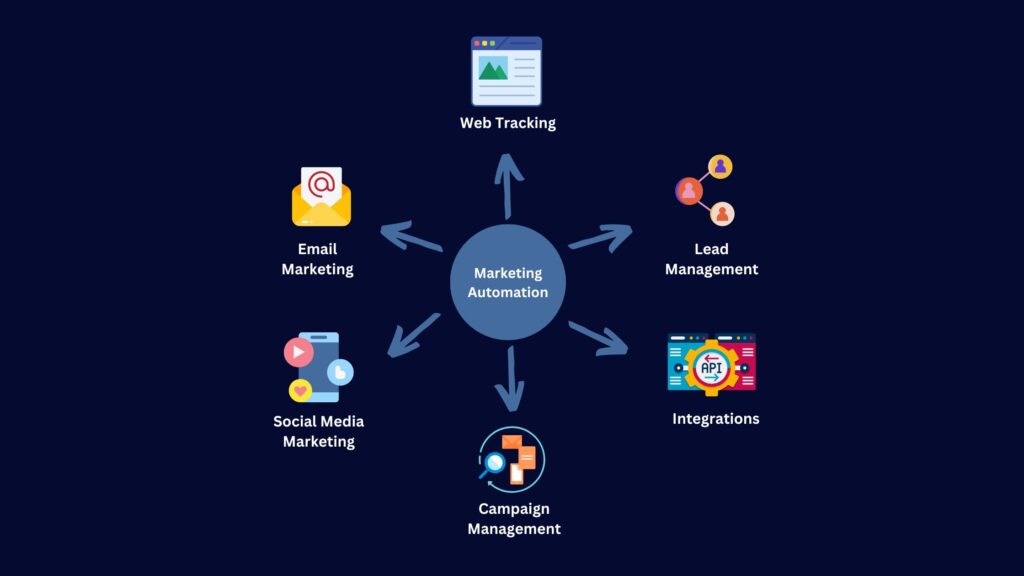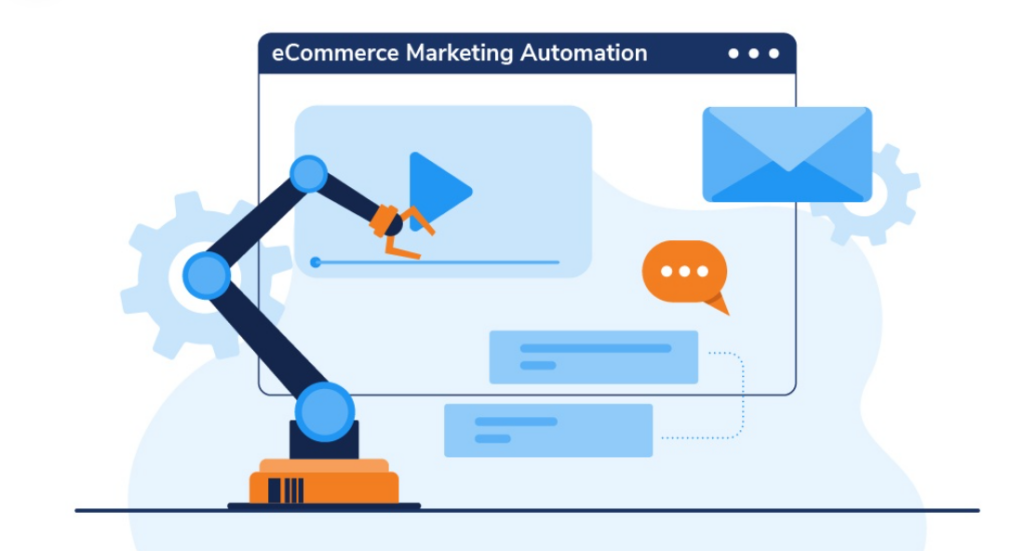
Key Takeaways
- Ecommerce marketing automation refers to the use of technology and software to automate and streamline marketing processes for online businesses.
- Key features include email automation, personalized messaging, workflow automation, analytics, and integration capabilities.
- Lead nurturing and scoring empowers businesses to guide customers through the sales funnel and prioritize high-quality leads.
- Social media automation expands brand reach, maintains consistency, and drives traffic to the eCommerce website.
- Customer segmentation and AI-powered recommendations deliver personalized experiences, boost conversions, and increase average order value.
In today’s fast-paced and highly competitive digital landscape, eCommerce businesses need effective strategies to streamline their marketing efforts and drive growth.
This is where eCommerce marketing automation comes into play.
Businesses can optimize their marketing processes, improve efficiency, and deliver personalized customer experiences by leveraging automation tools and technologies.
In this guide, we will explore the concept of eCommerce marketing automation, strategies, benefits and provide practical tips to get started.
What is eCommerce marketing automation?

eCommerce marketing automation refers to using technology and software to automate and streamline marketing processes for online businesses.
It employs intelligent workflows, triggers, and personalized messaging to engage customers, nurture leads, and drive conversions throughout the customer journey.
By automating repetitive tasks and leveraging data insights, eCommerce marketing automation allows businesses to deliver targeted, timely, and relevant communications.
Example: Imagine an eCommerce store that wants to recover abandoned carts and re-engage potential customers.
With eCommerce marketing automation, they can set up an automated email campaign that triggers a personalized email to be sent to customers who abandon their carts.
The email can include a gentle reminder of the items left behind and a special offer or incentive to entice them back to complete their purchase.
Automating this process allows the eCommerce store to efficiently recover lost sales and drive revenue growth without manual intervention for each abandoned cart.
Key features of eCommerce marketing automation tools

1. Email automation
Experience the power of automated email campaigns. Send captivating welcome emails to greet new customers and set the stage for a remarkable shopping journey.
Recover lost sales with abandoned cart reminders that nudge customers back to complete their purchases.
Enhance post-purchase satisfaction by sending thoughtful follow-up emails that foster loyalty and repeat business.
2. Personalization
Unleash the magic of personalization. With eCommerce marketing automation, you can create unique experiences for each customer.
Customize content, product recommendations, and offers based on individual preferences, browsing history, and past purchases.
Watch as customers feel understood, engaged, and eager to explore what your eCommerce store offers.
3. Workflow automation
Enter the world of seamless workflow automation. Design intelligent workflows that respond to specific customer interactions or events.
Automatically trigger actions based on milestones such as website visits, email clicks, or purchases.
From personalized product recommendations to tailored follow-up emails, automation ensures customers receive the right message at the right time.
4. Analytics and Reporting
Embrace the power of data-driven decision-making. eCommerce marketing automation tools offer robust analytics and reporting capabilities.
Track and measure the performance of your campaigns, customer engagement levels, and return on investment (ROI).
Gain insights into what works and needs improvement, allowing you to optimize your strategies for maximum impact.
5. Integration capabilities
Unlock the potential of seamless connectivity. eCommerce marketing automation tools thrive on integration.
They seamlessly integrate with your existing marketing tools and systems, such as your eCommerce platform, CRM system, and social media channels.
This integration facilitates data synchronization, enabling you to automate workflows across platforms and create cohesive customer experiences.
By aligning with iPaaS vendors, these tools simplify data synchronization, enabling you to automate workflows across platforms and create cohesive customer experiences.
6. Lead nurturing and scoring
Automate sales engagement to guide potential customers seamlessly through the sales funnel, leveraging automated sequences to educate, engage, and convert effectively.
Assign lead scores based on their actions, allowing you to prioritize and focus on high-quality leads.
eCommerce marketing automation empowers you to cultivate relationships and maximize conversion opportunities.
7. Social media automation
Extend your reach across social media platforms. Automate your social media posting schedules and effortlessly share captivating content with your followers.
Coordinate your social media efforts with your overall marketing automation strategy, ensuring a consistent brand presence and driving traffic to your eCommerce website.
8. Customer segmentation
eCommerce marketing automation tools enable you to segment your customer base based on relevant criteria such as demographics, purchase history, or engagement level.
Tailor your automation workflows and messaging to deliver personalized experiences that resonate with each segment.
Experience the power of targeted marketing and watch customer satisfaction and conversions soar.
9. Omnichannel automation
Embrace a seamless customer experience across channels. Automate interactions and messaging across multiple touchpoints, including email, social media, website, and mobile apps.
Deliver consistent and cohesive experiences, regardless of where customers engage with your brand. Build loyalty and foster long-term relationships that transcend individual platforms.
10. AI-powered recommendations
Leverage machine learning algorithms to generate smart and personalized product recommendations.
Automatically suggest related items, upsells, or cross-sells based on customer preferences and behaviors.
Watch your average order value increase as customers discover new products they love.
Tips for successful eCommerce marketing automation

1. Set clear goals and objectives
- Define specific objectives for your eCommerce marketing automation efforts, such as increasing conversion rates or improving customer retention.
- Ensure your goals are measurable, time-bound, and aligned with your business objectives.
2. Understand your target audience
- Conduct market research, leveraging tools like market research AI tools, to gain insights into your target audience’s demographics, preferences, and behaviors.
- Use this information to segment your audience and deliver personalized messages that resonate with their needs and interests.
3. Segment your audience for personalized messaging
- Divide your customer base into segments based on purchase history, browsing behavior, or demographic information.
- Craft tailored messages and offers for each segment to drive engagement and conversions.
4. Create compelling and relevant content
- Develop high-quality, engaging content that aligns with your audience’s interests and needs.
- Use automation tools to deliver this content at the right time and through the most effective channels.
5. Test and optimize your automation workflows
- Continuously monitor and analyze the performance of your automation workflows.
- Experiment with different strategies, messaging, and timing to identify the most effective approaches.
- Make data-driven adjustments to optimize your automation efforts for better results.
6. Continuously analyze and measure performance
- Track key performance indicators (KPIs) to evaluate the effectiveness of your eCommerce marketing automation.
- Leverage analytics tools to gain insights into customer behavior, campaign performance, and areas for improvement.
- Regularly review and analyze your automation metrics to identify areas of success and areas that require adjustments.
Strategies for eCommerce marketing automation

1. Email marketing automation
A. Automated email campaigns
- Set up automated email sequences for events like welcomes, order confirmations, or follow-ups. Tools like Weopi AI – a smart chatbot with features like image creation, coding, and interactive conversations can help personalize and enhance these emails.
- Use dynamic content to personalize email messages based on customer data and preferences.
- Incorporate cross-selling and upselling opportunities to maximize customer value.
B. Personalized email content and recommendations
- Leverage customer data to tailor email content and product recommendations to each individual.
- Use behavioral triggers like browsing history or previous purchases to deliver relevant and targeted messages.
- Implement dynamic email content that updates in real time based on user interactions or inventory changes.
C. Abandoned cart recovery emails
- Automatically send personalized emails to customers who have abandoned their shopping carts.
- Include compelling incentives, such as discounts or free shipping, to encourage customers to complete their purchases.
- Use urgency and scarcity tactics to create a sense of FOMO (fear of missing out) and prompt action.
2. Social media automation
A. Scheduled social media posts
- Monitor and engage with your audience by responding to comments and messages promptly.
B. Social media engagement and response automation
- Utilize chatbots or automated messaging systems to handle customer inquiries and provide immediate responses.
- Set up automated replies and predefined messaging sequences to engage with customers and nurture leads.
3. Customer relationship management automation
A. Lead nurturing and management
- Implement automated lead nurturing workflows to guide potential customers through the sales funnel.
- Use personalized emails, targeted content, and automated follow-ups to nurture leads and build relationships.
- Score leads based on their interactions and behaviors to prioritize sales efforts.
B. Customer data management
- Automate data collection and consolidation from various touchpoints to create a unified customer view.
- Use CRM systems to store and analyze customer data, including purchase history, preferences, and interactions.
- Leverage this data to personalize marketing messages and improve overall customer experience.
C. Sales and revenue tracking
- Integrate your eCommerce platform with CRM systems to automatically track sales and revenue data.
- Monitor customer behavior, such as repeat purchases or average order value, to identify opportunities for upselling or cross-selling.
- Generate reports and analytics to measure the effectiveness of your marketing automation efforts.
Getting started with eCommerce marketing automation

1. Set clear goals and objectives
To successfully embark on eCommerce marketing automation, it is crucial to establish clear goals and objectives. Here are some detailed steps and additional points to consider:
A. Define key performance indicators
- Determine the specific metrics that align with your business objectives, such as conversion rate, revenue growth, customer lifetime value, or average order value.
- These KPIs will serve as benchmarks to measure the success of your automation efforts and gauge the impact on your business.
B. Determine specific automation requirements
- Identify areas within your marketing processes that can benefit from automation.
- Consider the types of tasks and workflows that can be streamlined and made more efficient through automation.
- Look for repetitive or time-consuming activities that can be automated to free up your marketing team’s time for more strategic initiatives.
2. Choose the right eCommerce automation platform
Selecting the appropriate eCommerce automation platform is a critical decision. Here are some additional points to consider:
A. Research and evaluate eCommerce automation companies
- Conduct thorough research on different automation platforms available in the market.
- Assess their features, capabilities, and pricing to find the one that best suits your specific requirements.
- Read customer reviews and case studies to gain insights into the effectiveness and reliability of the platforms.
B. Consider integration capabilities with existing tools and systems
- Ensure the automation platform seamlessly integrates with your existing eCommerce platform, CRM system, and other marketing tools.
- Look for APIs and integration options that facilitate data synchronization and streamline workflows between systems.
C. Assess scalability and flexibility for future growth
- Choose an automation platform that can scale alongside your business and accommodate future expansion.
- Consider the ability to customize automation workflows to adapt to changing marketing needs and leverage emerging opportunities.
3. Implementing marketing automation for eCommerce
Once you have established your goals and chosen the right automation platform, it’s time to implement marketing automation for eCommerce.
Here are some additional points to guide you through the process:
A. Identify automation opportunities in your marketing processes
- Conduct a comprehensive analysis of your current marketing workflows to identify tasks that can be automated.
- Prioritize areas that will have the most significant impact on your marketing goals and customer experience.
B. Develop a customer segmentation strategy
- Divide your customer base into segments based on relevant criteria such as demographics, purchase history, engagement level, or preferences.
- This segmentation will enable you to deliver personalized experiences through tailored automation workflows and targeted messaging.
C. Create automated workflows and campaigns
- Map out the customer journey from awareness to conversion and beyond.
- Design automated workflows that guide customers through different stages, delivering the right content at the right time.
D. Test and optimize automation strategies:
- Implement A/B testing to compare different variations of your automation workflows and campaigns.
- Continuously monitor performance metrics such as open rates, click-through rates, conversion rates, and revenue generated.
- Make data-driven adjustments to optimize your strategies and improve overall results.
4. Measure and analyze results
To ensure the effectiveness of your eCommerce marketing automation efforts, measuring and analyzing results is crucial.
Here are additional points to consider:
A. Track performance metrics and KPIs:
- Utilize analytics tools to monitor and measure the impact of your automation efforts.
- Track key metrics such as revenue generated, customer engagement, campaign ROI, average order value, or customer retention rate
B. Use analytics tools to gain insights
- Analyze customer behavior, preferences, and interactions to identify patterns and trends.
- Leverage data insights to refine your automation strategies, improve targeting, and enhance the overall customer experience.
- Identify areas where automation has had a significant impact and areas that require further optimization.
C. Make data-driven decisions for further optimization
- Regularly review and analyze your automation data to identify areas for improvement.
- Utilize the insights gained from data analysis to make data-driven decisions and refine your marketing automation workflows.
- Adjust automation parameters, messaging, or segmentation based on the data to optimize performance.
D. Continuously innovate and evolve
- Stay updated with the latest trends and advancements in eCommerce marketing automation.
- Explore new features and functionalities offered by your chosen automation platform.
- Seek opportunities to automate additional marketing processes and expand your automation efforts as your business grows.
E. Provide ongoing training and support
- Ensure your marketing team receives proper training on utilizing the automation platform effectively.
- Foster a culture of continuous learning and improvement within your team.
- Provide ongoing support to address any challenges or questions that arise during the implementation and optimization phases.
F. Collaborate with automation experts
- Consider partnering with eCommerce automation companies or consultants who specialize in marketing automation.
- Seek their expertise to fine-tune your strategies, overcome challenges, and maximize the benefits of automation.
- Leverage their industry knowledge and best practices to drive better results.
Key benefits of eCommerce marketing automation

1. Improved operational efficiency
- E-commerce marketing automation streamlines and automates manual tasks, saving time and resources for businesses.
- By eliminating repetitive and time-consuming marketing activities, automation allows teams to focus on more strategic and creative initiatives.
- Automation enables businesses to achieve higher efficiency in their marketing operations, leading to enhanced productivity and streamlined workflows.
2. Reduced customer churn rate
- Personalized and timely communication facilitated by e-commerce marketing automation helps retain customers and reduce churn.
- Automated workflows enable targeted re-engagement efforts for inactive or at-risk customers, increasing the chances of retention.
- By nurturing customer relationships through automated campaigns, businesses can prevent customer attrition and foster long-term loyalty.
3. Increased revenue and sales
- E-commerce marketing automation enables personalized product recommendations and upselling opportunities, leading to higher average order value and revenue.
- Automated campaigns, such as abandoned cart recovery emails, help recover lost sales by re-engaging customers and boosting conversion rates.
- By delivering relevant and timely offers, automation drives increased purchase frequency and customer spend, ultimately driving revenue growth.
4. Better customer retention and loyalty
- Personalized messaging and tailored experiences facilitated by e-commerce marketing automation foster customer loyalty.
- Automation allows for consistent and relevant communication throughout the customer journey, strengthening relationships.
- By delivering personalized content, recommendations, and offers, businesses can enhance customer satisfaction, increase customer lifetime value, and build a loyal customer base.
5. Time and resource savings
- Automating marketing tasks frees up valuable time for marketers, enabling them to focus on strategic planning and high-value activities.
- E-commerce marketing automation reduces the need for manual data entry and repetitive processes, optimizing resource allocation and efficiency.
- With automation, businesses can accomplish more in less time, achieving higher productivity and maximizing the utilization of their resources.
6. Enhanced customer targeting and segmentation
- E-commerce marketing automation tools offer sophisticated customer segmentation capabilities, allowing businesses to target specific audiences with personalized marketing messages.
- By delivering relevant content to the right audience segments, businesses can increase engagement, improve conversion rates, and drive more effective marketing campaigns.
- Automation enables businesses to leverage customer data to create highly targeted and personalized marketing experiences, resulting in improved customer satisfaction and higher ROI.
7. Streamlined marketing processes
- E-commerce marketing automation simplifies complex marketing processes by automating repetitive tasks and workflows.
- It ensures consistency and accuracy in messaging, branding, and customer interactions across various marketing channels.
8. Automation provides quality data
- E-commerce marketing automation tools collect and analyze valuable data on customer behavior, preferences, and engagement.
- This data can be leveraged to make informed decisions, refine marketing strategies, and drive targeted campaigns.
- By gaining insights from automation-generated data, businesses can continuously optimize their marketing efforts, deliver more relevant experiences, and achieve better overall performance.
Conclusion
As we reach the end of our exploration into eCommerce marketing automation, it becomes evident that its benefits are nothing short of remarkable.
For further learning, resources like “Marketing Automation for Dummies” can provide comprehensive insights and practical guidance on implementing successful eCommerce marketing automation strategies.
The advantages are game-changing, from time and resource savings to precise customer targeting or streamlined marketing processes.
To embark on this transformative journey, it is essential to set clear goals, choose the right automation platform, and meticulously implement tailored workflows.
Remember, optimization and adaptation are essential.
You can ensure your business thrives in the ever-evolving eCommerce landscape by continuously measuring, analyzing, and refining your automation strategies.
So, seize the opportunity, harness the power of eCommerce marketing automation, and elevate your business to unprecedented success.
